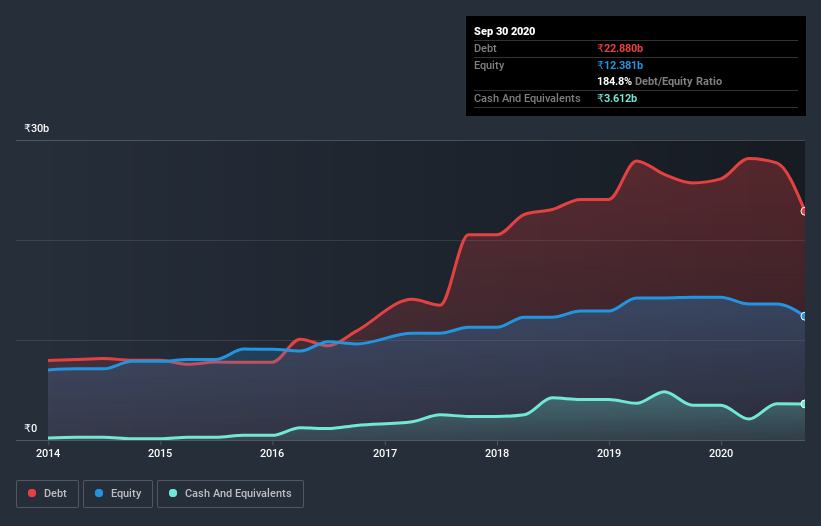Stock Analysis

Legendary fund manager Li Lu (who Charlie Munger backed) once said, 'The biggest investment risk is not the volatility of prices, but whether you will suffer a permanent loss of capital.' So it might be obvious that you need to consider debt, when you think about how risky any given stock is, because too much debt can sink a company. We note that Himatsingka Seide Limited (NSE:HIMATSEIDE) does have debt on its balance sheet. But the real question is whether this debt is making the company risky.
When Is Debt Dangerous?
Debt is a tool to help businesses grow, but if a business is incapable of paying off its lenders, then it exists at their mercy. In the worst case scenario, a company can go bankrupt if it cannot pay its creditors. While that is not too common, we often do see indebted companies permanently diluting shareholders because lenders force them to raise capital at a distressed price. Of course, plenty of companies use debt to fund growth, without any negative consequences. The first step when considering a company's debt levels is to consider its cash and debt together.
See our latest analysis for Himatsingka Seide
What Is Himatsingka Seide's Debt?
You can click the graphic below for the historical numbers, but it shows that Himatsingka Seide had ₹22.9b of debt in September 2020, down from ₹25.7b, one year before. However, it also had ₹3.61b in cash, and so its net debt is ₹19.3b.

How Strong Is Himatsingka Seide's Balance Sheet?
According to the last reported balance sheet, Himatsingka Seide had liabilities of ₹18.4b due within 12 months, and liabilities of ₹19.2b due beyond 12 months. On the other hand, it had cash of ₹3.61b and ₹1.59b worth of receivables due within a year. So it has liabilities totalling ₹32.4b more than its cash and near-term receivables, combined.
This deficit casts a shadow over the ₹13.3b company, like a colossus towering over mere mortals. So we definitely think shareholders need to watch this one closely. After all, Himatsingka Seide would likely require a major re-capitalisation if it had to pay its creditors today.
We measure a company's debt load relative to its earnings power by looking at its net debt divided by its earnings before interest, tax, depreciation, and amortization (EBITDA) and by calculating how easily its earnings before interest and tax (EBIT) cover its interest expense (interest cover). The advantage of this approach is that we take into account both the absolute quantum of debt (with net debt to EBITDA) and the actual interest expenses associated with that debt (with its interest cover ratio).
Himatsingka Seide shareholders face the double whammy of a high net debt to EBITDA ratio (13.2), and fairly weak interest coverage, since EBIT is just 0.032 times the interest expense. This means we'd consider it to have a heavy debt load. Even worse, Himatsingka Seide saw its EBIT tank 99% over the last 12 months. If earnings continue to follow that trajectory, paying off that debt load will be harder than convincing us to run a marathon in the rain. There's no doubt that we learn most about debt from the balance sheet. But it is future earnings, more than anything, that will determine Himatsingka Seide's ability to maintain a healthy balance sheet going forward. So if you're focused on the future you can check out this free report showing analyst profit forecasts.
Finally, while the tax-man may adore accounting profits, lenders only accept cold hard cash. So the logical step is to look at the proportion of that EBIT that is matched by actual free cash flow. Over the last three years, Himatsingka Seide reported free cash flow worth 5.6% of its EBIT, which is really quite low. That limp level of cash conversion undermines its ability to manage and pay down debt.
Our View
On the face of it, Himatsingka Seide's EBIT growth rate left us tentative about the stock, and its level of total liabilities was no more enticing than the one empty restaurant on the busiest night of the year. And furthermore, its net debt to EBITDA also fails to instill confidence. It looks to us like Himatsingka Seide carries a significant balance sheet burden. If you harvest honey without a bee suit, you risk getting stung, so we'd probably stay away from this particular stock. There's no doubt that we learn most about debt from the balance sheet. But ultimately, every company can contain risks that exist outside of the balance sheet. Case in point: We've spotted 2 warning signs for Himatsingka Seide you should be aware of, and 1 of them is a bit concerning.
At the end of the day, it's often better to focus on companies that are free from net debt. You can access our special list of such companies (all with a track record of profit growth). It's free.
If you decide to trade Himatsingka Seide, use the lowest-cost* platform that is rated #1 Overall by Barron’s, Interactive Brokers. Trade stocks, options, futures, forex, bonds and funds on 135 markets, all from a single integrated account. Promoted
Valuation is complex, but we're helping make it simple.
Find out whether Himatsingka Seide is potentially over or undervalued by checking out our comprehensive analysis, which includes fair value estimates, risks and warnings, dividends, insider transactions and financial health.
View the Free AnalysisThis article by Simply Wall St is general in nature. It does not constitute a recommendation to buy or sell any stock, and does not take account of your objectives, or your financial situation. We aim to bring you long-term focused analysis driven by fundamental data. Note that our analysis may not factor in the latest price-sensitive company announcements or qualitative material. Simply Wall St has no position in any stocks mentioned.
*Interactive Brokers Rated Lowest Cost Broker by StockBrokers.com Annual Online Review 2020
Have feedback on this article? Concerned about the content? Get in touch with us directly. Alternatively, email editorial-team (at) simplywallst.com.
About NSEI:HIMATSEIDE
Himatsingka Seide
Designs, develops, manufactures, distributes, and retails home textile products in North America, India, the Asia Pacific, Europe, the Middle East, Africa, and internationally.
Mediocre balance sheet and slightly overvalued.

